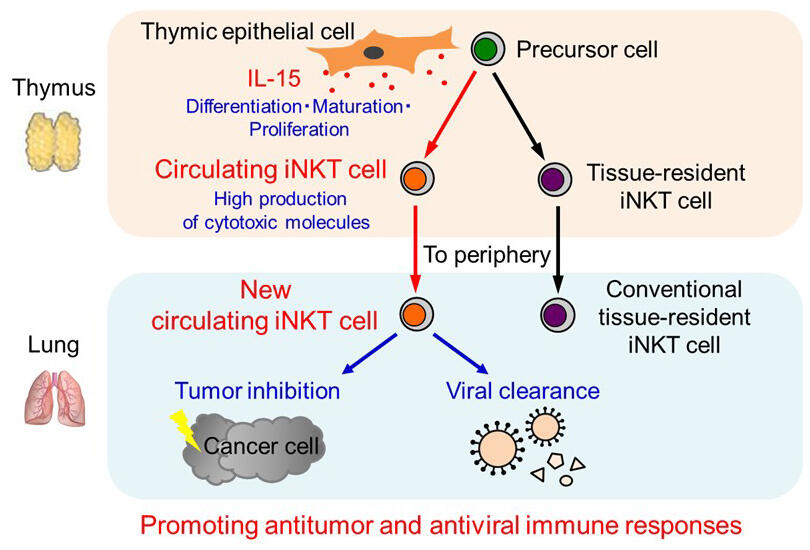A research group consisting of Assistant Professor Guangwei Cui and Professor Koichi Ikuta of the Institute for Life and Medical Sciences, Kyoto University, and their colleagues, has discovered new circulating iNKT (invariant NKT) cells that play a key role in anti-tumor and anti-viral immunity. The group also clarified that cell differentiation into the circulating iNKT cells they have discovered is induced by interleukin-15 (IL-15) derived from thymic lipid epithelial cells, and that circulating iNKT cells have a high level of defense against melanoma cell metastasis in the lungs and infection with the influenza virus. Circulating iNKT cells also exist in human peripheral blood. "We think it will be possible to use circulating iNKT cells for cancer treatments via approaches such as CAR-T cell therapy," says Professor Ikuta. Their outcomes were published online in Science Immunology.

Provided by Kyoto University
Natural killer T cells (NKT cells) sense glycolipids derived from pathogens and determine the direction of the immune response by secreting large amounts of cytokines. Some of these cells are always present in tissues, and rapidly express T cell receptors by recognizing glycolipid antigens in the early stages of the immune response; these are iNKT cells. These iNKT cells play the role of connecting natural and acquired immunity by quickly producing large quantities of cytokines and cytotoxic molecules. As lymphocytes that are always present in tissues, they are associated with various diseases, including cancer, infectious diseases, chronic inflammation and autoimmune disorders, and so researchers have focused on them as cells that could be useful in immune cell therapy.
On the other hand, IL-15 is a key cytokine in iNKT cell differentiation, maintenance and response, and attention is being paid to it as a candidate for anti-tumor immunotherapy. The research group has previously identified IL-15 production cells in various tissues, but did not know how each of the IL-15 production cells controls the heterogeneity and functions of iNKT cells.
With this in mind, the group analyzed iNKT cells in different tissues. First, they used flow cytometry analysis on wild-type mice, focusing on the thymus where T cells are differentiated to analyze the expression levels of CD244 (NK cell receptor) and CXCR6 (chemokine receptor), and found that iNKT cells can be categorized into two types. They also used comprehensive gene expression analysis to clarify that one of these expresses genes similarly to NK cells, which have high expression of INF-γ and cytotoxic molecules.
The group created and analyzed a mouse without thymic epithelial cell-specific IL-15 and found it no longer had highly migratory iNKT cells with cytotoxic activity. To confirm whether these cells really migrate, they carried out a parabiosis experiment. Two mice were joined together and the iNKT cells in their lungs were investigated two months later. The group found that the iNKT cells of the partner mouse were present. In other words, this proved that iNKT cells circulate within the body.
To analyze the function of the circulating iNKT cells, the group transplanted circulating iNKT cells into a mouse model with melanoma cells metastasized in the lungs. When they did so, there was a significant decrease in metastatic lesions in the transplant group. They also transplanted circulating iNKT cells in an influenza virus infection experiment. The remaining viral load dropped to around a third. Furthermore, the group discovered that cytotoxic circulating iNKT cells exist by carrying out RNA-seq using human peripheral blood.
Cui noted, "The mice we investigated for this study were 48 weeks old, and the circulating iNKT cells decreased as they aged. It seems that they are also influenced by the intestinal flora. In humans, there are less circulating iNKT cells in people in their 50s than in people in their 20s. As there are few donors, we can't completely confirm the results. Next time we need to carry out functional analysis with more donors."
Ikuta also commented, "The cooperation of circulating iNKT cells and iNKT cells resident in tissues makes it possible to effectively induce an immuno-response. In the future, we want to focus on developing ways to induce circulating iNKT cell and tissue-resident iNKT cell differentiation, and a system to cultivate them in large quantities."
Journal Information
Publication: Science Immunology
Title: A circulating subset of iNKT cells mediates antitumor and antiviral immunity
DOI: 10.1126/sciimmunol.abj87
This article has been translated by JST with permission from The Science News Ltd.(https://sci-news.co.jp/). Unauthorized reproduction of the article and photographs is prohibited.




